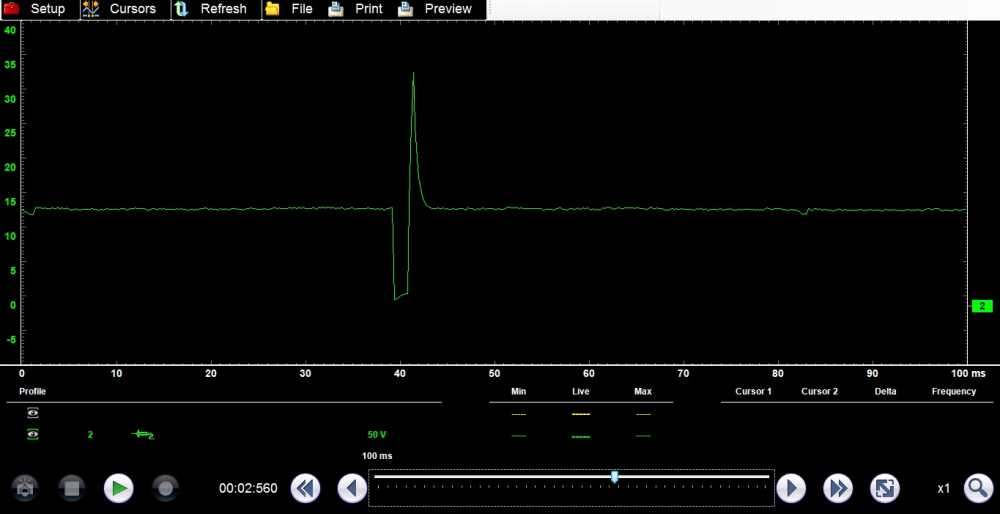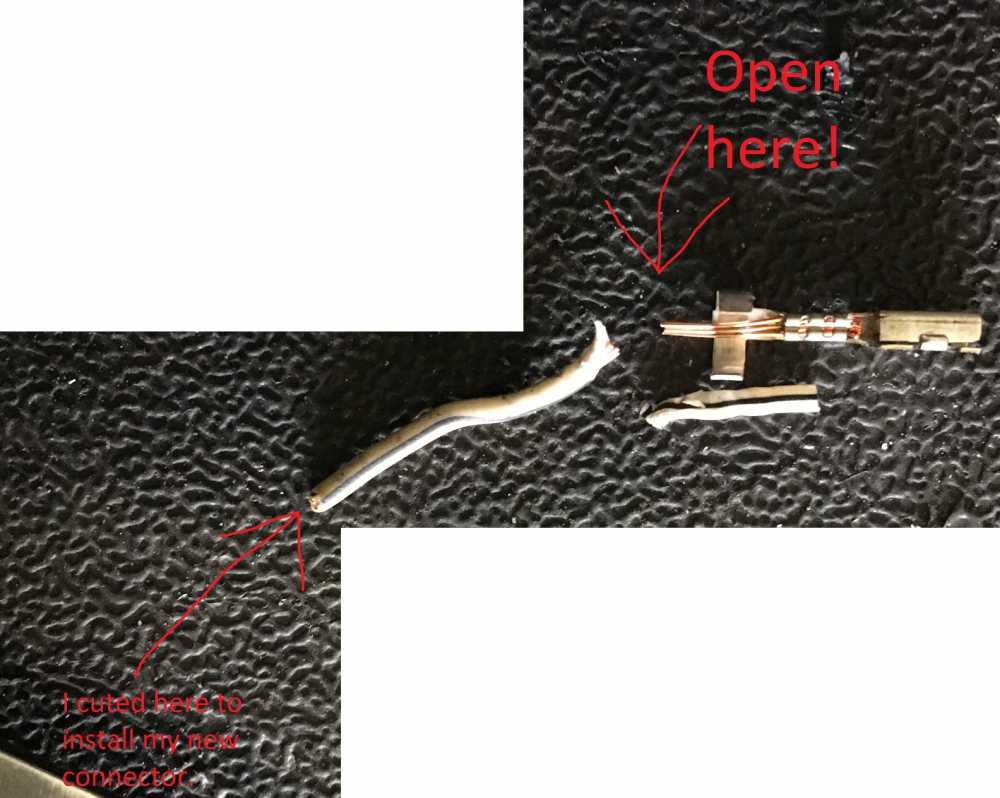*** Restricting New Posts to SD Premium Members ONLY *** (09 May 2025)
Just made a new account? Can't post? Click above.
Question on a coil waveform!
- Rukerin
-
Topic Author
- Offline
- Junior Member
-

- Posts: 26
- Thank you received: 2
Will post them waveforms . If someone could explain , in advance thanks!
This is with broken wire.
This after the fix.
Please Log in or Create an account to join the conversation.
- Tyler
-

- Offline
- Moderator
-

- Full time HACK since 2012
- Posts: 6053
- Thank you received: 1523
Just for my info, was the truck running during your second capture? No offense meant here, but it looks like your scope didn't have a good ground at that time. The sharp positive and negative spikes followed by a curve are somewhat characteristic of that, seen it many times on my own scope.
It might help me to answer your questions if I knew where exactly you were during these captures. Here's a diagram for reference:
Were you scoping the white/black wire between the ignition coil and the ICM, or were you scoping the white wire from the ICM to the PCM? Not trying to be picky, just want to make sure I'm on the same page.
Please Log in or Create an account to join the conversation.
- Rukerin
-
Topic Author
- Offline
- Junior Member
-

- Posts: 26
- Thank you received: 2
Please Log in or Create an account to join the conversation.
- Tyler
-

- Offline
- Moderator
-

- Full time HACK since 2012
- Posts: 6053
- Thank you received: 1523
Rukerin wrote: I was backprobing on ICM connector "D" wire on you're picture. And forgot to mention it was cranking only on both pictures , and after I fixed it i connected a test light from coil post to ground. I remember that coil could be damaged if the spark had nowhere to go. And for ground had a jumper wire directly to battery negative post.
Ooooooh, OK then, I take it back! The after waveform somewhat makes sense now, knowing that the spark is shorted out. You're completely right, 'deadheading' the coil secondary output can do damage. Good move by giving the spark an outlet.
That 'taper' off after a spike also happens when the spark is shorted. Here's an example of a failed COP primary control waveform on a Jeep Compass:
The taper is there because the energy is getting bled to ground, instead of going across an air gap and creating a burn line in the waveform.
Please Log in or Create an account to join the conversation.
- Rukerin
-
Topic Author
- Offline
- Junior Member
-

- Posts: 26
- Thank you received: 2
Please Log in or Create an account to join the conversation.
- Tyler
-

- Offline
- Moderator
-

- Full time HACK since 2012
- Posts: 6053
- Thank you received: 1523
Rukerin wrote: Thanks for the info Tyler ! And sorry for all the questions , noobie here
but I was triyng to find out if the change of the waveform was caused by the ignition coil magnetic field and all that stuff or you think the change was made by the computer knowing it had a good connection? What im trying to learn is if some other day I get a no spark Chevy with a bad coil and connect into that wire would I see something similar to the first image or the second one?
No worries, ask away!
I believe the change in waveform has to do with the coil now building/collapsing a magnetic field, since you probably restored current flow through the coil with your wiring repair. You mentioned finding an open wire, where was it exactly? Your 'before' waveform suggests that it wasn't a complete open, necessarily, but high resistance in the white/black wire between the coil and the ICM.
What you'd see in the case of a failed coil would depend on how the coil failed, exactly. An open or high resistance in the primary would look more like the first waveform. If you're a subscriber, there was a newer Premium video on a Nissan with a shorted secondary, great video:
For reference, with everything working correctly, the waveform should look something like this:
Please Log in or Create an account to join the conversation.
- Rukerin
-
Topic Author
- Offline
- Junior Member
-

- Posts: 26
- Thank you received: 2
Please Log in or Create an account to join the conversation.
- Tyler
-

- Offline
- Moderator
-

- Full time HACK since 2012
- Posts: 6053
- Thank you received: 1523
Rukerin wrote: Ok thanks!!! So you suggest that if I cut the wire completely I would have seen a flat line ? And yes you are correct the wire was not all the way cut I'll post a picture of it tomorrow . It was kind of internal damage because you could not see it. The strange things is it did not have continuity with the volt meter but I'm sad I did not ohm the wire maybe I can still do it with the connector! I'll see what I find out tomorrow.
Correct, if you cut the wire you'd end up with zero activity on that circuit. Really, that's pretty much what you had in the first capture, but apparently there was some kind of connection in there, 'cause you can see around 1V available when the coil driver is off. Great find, by the way!
Please Log in or Create an account to join the conversation.
- Rukerin
-
Topic Author
- Offline
- Junior Member
-

- Posts: 26
- Thank you received: 2
Please Log in or Create an account to join the conversation.
- Tyler
-

- Offline
- Moderator
-

- Full time HACK since 2012
- Posts: 6053
- Thank you received: 1523
Totally keep the waveform questions coming! We're happy to answer, and chances are good that someone else will benefit from reading the discussion, too.
Where to post them? Good question, 'cause it could make just as much sense to post them in the Diagnostic Tools section. I'd say if it's related to a vehicle you're trying to repair, post it here. Otherwise, the Diagnostic section.
Please Log in or Create an account to join the conversation.
- Rukerin
-
Topic Author
- Offline
- Junior Member
-

- Posts: 26
- Thank you received: 2
Please Log in or Create an account to join the conversation.
- Andy.MacFadyen
-

- Offline
- Moderator
-

- Posts: 3353
- Thank you received: 1037
Primary current and primary voltage waveforms really show different but related things, which to go for first is really a matter of how easy it is to get access and what equipment is available.
Primary current is often the quick and easy to do and you can often look at more than one cylinder at a time, it is a 100% surefire way to spot a shorted primary or a failure of the control pulse, but won't tell you anything about the secondary HT spark.
Primary voltage is really a sneaky way of looking at secondary HT voltage, it will tell you if an HT spark is happening and its durration although it will not always tell you if the spark is occurring in the cylinder.
Looking directly at the secondary voltage used to be the go-to method but these days it is rare to find an engine you can clip a capacitive HT probe directly over the plug lead.
COP probes tend to be a bit hit or miss and the wave forms they produce tend to vary greatly, but they are quick and easy and sometimes the only method possible.
When I suspect a coil has a secondary HT fault I generally stress test the coil to see if it will produce at least a 25mm (1") spark, about 25kV working on the rough rule of thumb that every 1mm = 1kV
" We're trying to plug a hole in the universe, what are you doing ?. "
(Walter Bishop Fringe TV show)
Please Log in or Create an account to join the conversation.
- Rukerin
-
Topic Author
- Offline
- Junior Member
-

- Posts: 26
- Thank you received: 2
Please Log in or Create an account to join the conversation.






